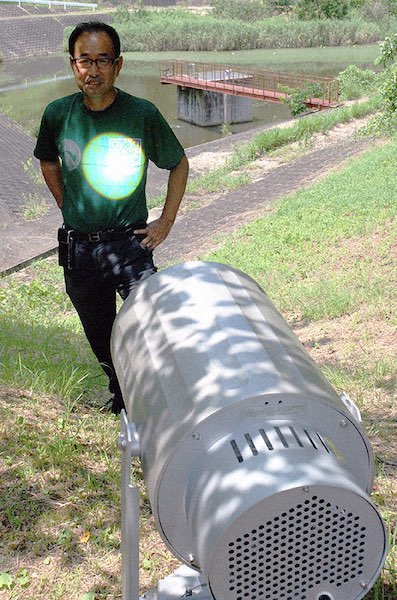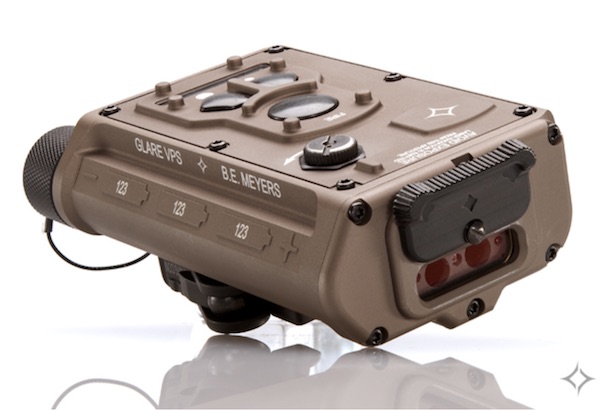Home
A comprehensive resource for safe and responsible laser use
Japan: Laser searchlight proposed to use QR codes to rescue hikers and climbers
The team, which is conducting the experiment at a campus in the western Japan city of Nara, has successfully scanned the two-dimensional code from a distance of about 300 meters and aims to put the system into practical use in the near future.
The code for the system measures about 11 centimeters (4.3 inches) on each side and is made from a retroreflective material. The print employs the same principle as that for reflecting road signs and can be scanned by a powerful laser searchlight.

A laser searchlight lights up a QR code on professor Yoshinobu Maeda's shirt at a Kindai University campus in the city of Nara. (Mainichi/Yasuhiro Okawa)
In responding to an actual situation, the team works on the assumption that a large laser emitter will be loaded on a helicopter to scan the mountain surface. The machine can spot a QR code from the light reflected from the ground. It's possible to identify a disaster or accident victim if their personal information, such as name and sex, has been registered with the code.
The system is being developed by a team consisting of scientists at the Faculty of Science and Engineering, and the Faculty of Architecture at the university.
Team leader Yoshinobu Maeda, a professor with the Faculty of Science and Engineering, said, "The system is technically advanced to a level where it can be introduced. The problem is how we spread its use. It's necessary for many people who enter mountain areas to wear clothes with QR codes and for helicopters to be equipped with laser searchlights."
From The Mainichi
South Korea: Firefighter suggests how laser pointers can help in fighting fires
The net-like grid will make the surface contour visible.
eBay Korea hosts a contest for firefighters to find and then develop useful firefighting tools. Bethel also has submitted ideas for laser-projecting messages from the back of fire trucks onto streets. He said, “The laser pointers will display signs, such as ‘no entry’ or ‘this lane is occupied by a fire engine’. By doing so, it can help firefighters save time spent setting up a perimeter using traffic cones.”
From a July 16 2018 story in the Korea Times
US: Marines to buy 1,653 eye-safe laser dazzlers
- An infrared (1535nm) laser rangefinder determines the distance to a person or object. The closer the distance, the lower the laser power output.
- Near-field detection shuts off laser emission if a person or object is too close to the laser output aperture.
- A 3-axis gyroscope detects motion. If the Glare Recoil is suddenly moved, the laser shuts off until stability is resumed and an accurate determination of the distance to a person or object can be re-established: “This prevents hazardous irradiance in situations where Glare Recoil is moving faster than the laser rangefinder can detect objects and dose power output. This results in the prevention of eye hazard danger caused by rapid movement of the device (example: flagging) or improper situational awareness of the operator.”
With these technologies, the laser detects objects or people in the proximity of the beam and then self-adjusts the power output to maintain eye safety. The Nominal Ocular Hazard Distance is said to be 0 meters; the range is 10 feet to 10 miles.
Suggested uses include urban patrolling, cordon and search, crowd control, clearing facilities and security checkpoints.

The Glare Recoil is about the size of a Walkman tape player at 5.5” x 3” x 2”. It can mount on a rifle or be handheld.
Meyers also sells a Class 1M “Glare Helios” which has an FDA variance allowing sales to U.S. local, state and federal law enforcement, and U.S. flagged vessels.
From Marine Corps Times, Soldier Systems, and B.E. Meyers. A video produced by the company goes into detail about the specifications and how the person/object detection works.
US: Coast Guard seeks FDA waiver; wants to use laser illuminators on helicopters
Currently, the U.S. Department of Defense is permitted to self-certify their laser equipment and usage. The DoD’s Army, Air Force and Navy agencies do not need FDA approval of their helicopter-based laser illuminators. However, the Coast Guard is part of the Department of Homeland Security, which does not have a self-certification waiver. The Coast Guard must currently apply for FDA approval.
On April 14 2016, Rep. Duncan Hunter sent a letter to FDA, asking that the Coast Guard be permitted to self-certify their laser systems. Hunter called FDA’s policy “onerous and burdensome”.
One issue may be that the helicopter-based video system already has low-light and infrared capabilities. Although the laser illumination can further enhance the image, it may not be considered a necessity for operations.
From Seapower magazine